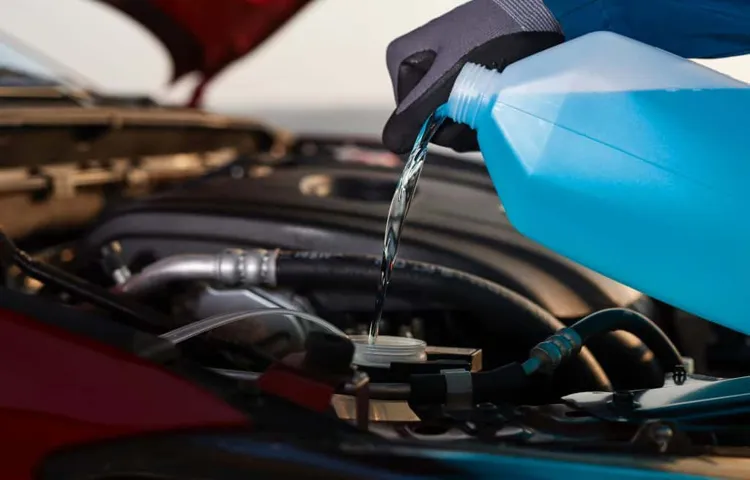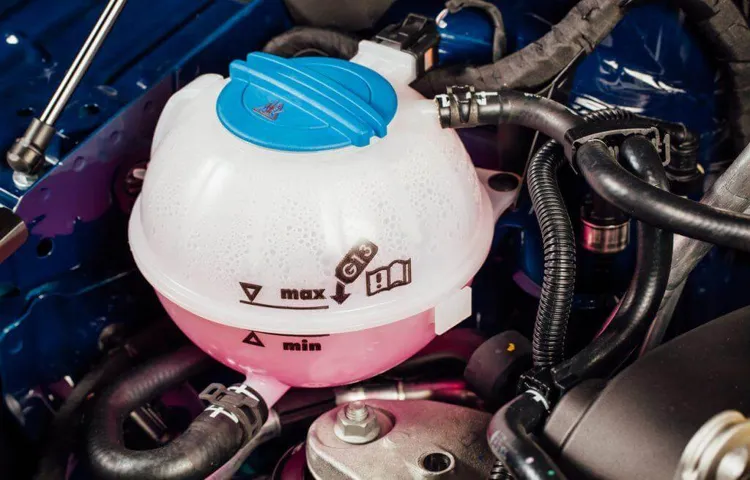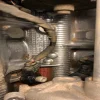If you’re wondering where your car’s antifreeze coolant goes, you’re not alone. The process of cooling the engine and maintaining its optimal temperature is a crucial one, especially during those sweltering summer months. Understanding how it works and where your antifreeze coolant goes is vital to keeping your car in top shape.
When you pour antifreeze coolant into your car’s cooling system, it circulates throughout the engine, helping to regulate the temperature. Over time, though, it can become contaminated or break down, which is why it’s important to replace it periodically. But where does the old coolant go? Typically, the old antifreeze coolant is drained out through a valve at the bottom of the radiator.
It’s then collected in a pan and disposed of properly. The new coolant is then poured back into the system, and the cycle begins anew. So, the next time you’re wondering where your antifreeze coolant goes, rest easy knowing that it’s doing its job, circulating throughout your engine and keeping it at the ideal temperature.
Just be sure to have it replaced regularly to keep your car running smoothly.
Table of Contents
Understanding the Purpose of Antifreeze Coolant
Antifreeze coolant is an essential component of a vehicle’s engine, as it helps prevent the engine from overheating or freezing in cold weather. The coolant is typically a mixture of water and ethylene glycol, which work together to regulate the temperature within the engine. When the vehicle is running, the coolant circulates throughout the engine, absorbing heat and transferring it to the radiator.
From there, the heat is released into the air, preventing the engine from overheating. In cold weather, the coolant also prevents the engine from freezing, which can cause damage to the engine block or various components within the engine. Overall, antifreeze coolant is a crucial part of every vehicle’s engine, helping to protect it from extreme temperatures and maintain optimal performance.
Preventing Engine Overheating
Antifreeze Coolant If you want to prevent your engine from overheating, then understanding the purpose of antifreeze coolant is essential. Antifreeze coolant is a liquid that is added to the radiator of your engine to help regulate its temperature. It contains a mix of water and ethylene glycol, which helps lower the freezing point of the liquid.
This means that even when temperatures drop, the liquid won’t freeze and damage your engine. Additionally, antifreeze coolant has a higher boiling point than water, which helps prevent your engine from overheating in hot weather. Antifreeze coolant is also an essential lubricant for the moving parts in your engine, which helps prevent wear and tear.
It’s important to regularly check the levels of your antifreeze coolant to ensure that your engine is running smoothly. So, next time you think about taking your car out for a long drive, be sure to check your antifreeze coolant levels to avoid any potential engine overheating problems.

Maintaining Engine Performance
Antifreeze Coolant Antifreeze coolant is a crucial component in maintaining the overall performance of your engine. Its primary purpose is to prevent the engine from overheating by regulating its temperature. This is particularly important during extreme weather conditions such as winter, where temperatures can drop below freezing point.
In such conditions, antifreeze coolant contains chemicals that prevent water from freezing within the engine, ensuring its smooth running. Additionally, antifreeze coolant also plays a role in preventing corrosion and other forms of damage to the engine. It contains rust inhibitors and lubricants that help protect the engine’s components, ultimately prolonging its lifespan.
Regularly checking and topping up antifreeze coolant levels is essential in ensuring your engine runs smoothly, without encountering the hiccups of overheating or corrosion. Therefore, it is prudent to ensure that you maintain your antifreeze coolant levels by visiting your mechanic for regular checkups.
Checking the Antifreeze Coolant Level
Antifreeze coolant is an essential component of your vehicle’s cooling system that helps regulate engine temperature and prevent overheating. But have you ever wondered where it goes or how often you should check its level? Well, antifreeze coolant can escape through leaks in the system or simply evaporate over time. Therefore, it is crucial to check the antifreeze coolant level every six months or so to avoid damaging your engine.
To check the level, wait for the engine to cool down, remove the radiator cap, and look at the level indicated on the coolant reservoir. If it’s below the minimum level, add a mixture of antifreeze coolant and distilled water until it reaches the proper level. But always remember to follow the specific guidelines mentioned in your vehicle’s owner manual.
Locating the Radiator
When it comes to maintaining your vehicle’s health, checking the antifreeze coolant level is crucial. Antifreeze coolant is responsible for keeping your car from overheating in extreme temperatures, and it can also prevent freezing in the winter months. To check the level of antifreeze coolant, you need to locate the car’s radiator.
Typically, radiators are found towards the front of the engine, and they are enclosed by a protective covering. Once you uncover the radiator, look for a plastic or metal cap at the top of the radiator. The cap will likely say “coolant only” or “do not open when hot.
” Remove the cap carefully, using a rag or cloth to avoid any hot steam or liquid escaping. Once the cap is off, take a peek inside the radiator to see the coolant level. If the coolant level is low, use a 50/50 mixture of antifreeze coolant and water to fill it up.
Maintaining a proper antifreeze coolant level will increase the longevity of your vehicle and ensure that you don’t find yourself stranded on the side of the road.
Identifying the Coolant Reservoir
When it comes to maintaining your vehicle’s engine, checking the antifreeze coolant level is essential to avoid overheating and engine damage. To do this, you need to locate the coolant reservoir. Depending on your vehicle, it might be a clear plastic tank located near the radiator or a metal container near the engine.
Once you find it, you can check the coolant level by looking at the marking on the reservoir. Ideally, the fluid should be at the “Full” line or a little below it. If the level is too low, you may need to add more coolant to prevent issues down the road.
Remember to always use the same type of coolant recommended by the vehicle manufacturer, as mixing different types can cause damage to the engine. By checking the coolant level regularly, you can ensure that your vehicle is running smoothly and avoid costly repairs.
Checking the Level with a Dipstick or Gauge
Antifreeze coolant level To ensure your engine runs smoothly, you need to check the antifreeze coolant level regularly. One way to do this is by using a dipstick or gauge. First, make sure the engine is cool before checking the level.
Then, locate the coolant reservoir tank, which is usually a translucent plastic container with a “high” and “low” mark on the side. If the coolant level is below the “low” mark, top it up with a mixture of antifreeze and water. It’s important to use the correct type of antifreeze specified by the manufacturer.
Once you’ve added the necessary amount, replace the cap and start the engine to check that the coolant circulates properly. Remember to recheck the level after a few days of driving to make sure the mixture is at the correct level. Keeping the coolant level at the optimum level can help prevent engine overheating and expensive repairs down the line.
Refilling Antifreeze Coolant
When it comes to maintaining your vehicle’s cooling system, refilling the antifreeze coolant is a crucial part of the process. But where does the coolant actually go? Typically, the coolant reservoir is located near the radiator and is marked with high and low level indicators. Before adding coolant, it’s important to check the manufacturer’s recommended coolant type and mix ratio to ensure proper operation and avoid damage.
Once you have the correct coolant, simply add it to the reservoir until it reaches the appropriate level. It’s important to note that adding too much coolant can cause pressure buildup and potentially damage the system, so be careful not to overfill. Regularly checking and refilling your coolant is an easy and necessary step in keeping your vehicle cool and functioning properly.
Using the Correct Type of Antifreeze Coolant
When it comes to refilling antifreeze coolant, it’s crucial to use the correct type of coolant to avoid damage to your engine. Most vehicles require either ethylene glycol or propylene glycol-based antifreeze coolant, and it’s essential to check your owner’s manual to ensure you’re using the right kind. Once you’ve determined the proper coolant type, you should also check the coolant’s concentration level, which should be a 50/50 mixture of water and antifreeze coolant.
Using too much or too little coolant can lead to overheating or corrosion damage to your engine. Before you begin refilling your coolant, make sure your engine has cooled down completely, and never attempt to remove the coolant cap when the engine is still hot. Taking proper care when refilling your antifreeze coolant can help extend the life of your engine and prevent costly repairs down the line.
Mixing Antifreeze and Water in the Right Ratio
If you are refilling your antifreeze coolant, it’s essential to mix the antifreeze and water in the right ratio. The most common ratio is 50:50, which means mixing equal parts of antifreeze and water. However, there are different ratios depending on the climate you live in and the type of antifreeze you are using.
For example, if you live in a colder climate, you might need a higher ratio of antifreeze to water to prevent the coolant from freezing. On the other hand, if you live in a warmer climate, you might need a lower ratio of antifreeze to water. It’s essential to check your vehicle manual or consult a professional mechanic to determine the correct ratio for your specific make and model.
Mixing the wrong ratio can cause engine damage or lead to poor performance. In summary, refilling antifreeze coolant is crucial for maintaining your vehicle’s performance, but mixing the right ratio is equally important.
Conclusion
Antifreeze coolant is like a chameleon – it goes wherever it needs to go to keep our engines running smoothly. It may seem like a mysterious substance, but in reality, it’s just doing its job by circulating through our cars’ systems and preventing them from freezing or overheating. So the next time you’re wondering where your antifreeze coolant went, just remember that it’s probably right where it needs to be – keeping your ride cool and collected.
“
FAQs
What is antifreeze coolant and where does it go in my car?
Antifreeze coolant is a type of liquid that is used to regulate engine temperature. It goes in the radiator and cooling system of your car.
Can I use water instead of antifreeze coolant in my car?
While water can be used in an emergency situation, it is not recommended as a long term solution. Antifreeze coolant offers better protection against freezing and overheating.
How often does antifreeze coolant need to be changed in my car?
It is recommended to change the antifreeze coolant every 2-5 years, depending on the manufacturer’s recommendations and the type of coolant used.
What happens if I use the wrong type of antifreeze coolant in my car?
Using the wrong type of antifreeze coolant can cause engine damage and reduce the effectiveness of the coolant. Always use the recommended type for your specific make and model.
Can I mix different types of antifreeze coolant in my car?
It is not recommended to mix different types of antifreeze coolant, as they can have different chemical compositions and lead to engine damage. Stick to the same type that is recommended for your car.
How do I check the level of antifreeze coolant in my car?
Check your car’s owner manual for specific instructions, but typically the coolant level can be checked by looking at the coolant reservoir tank or by opening the radiator cap when the engine is cool.
What should I do if my car is overheating despite having antifreeze coolant?
If your car is overheating despite having the proper amount of antifreeze coolant, it may be a sign of a more serious issue and should be inspected by a mechanic.



